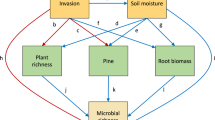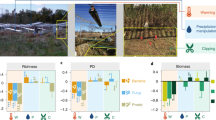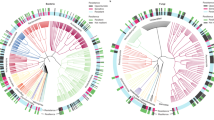Abstract
Soil fungi are fundamental to plant productivity, yet their influence on the temporal stability of global terrestrial ecosystems, and their capacity to buffer plant productivity against extreme drought events, remain uncertain. Here we combined three independent global field surveys of soil fungi with a satellite-derived temporal assessment of plant productivity, and report that phylotype richness within particular fungal functional groups drives the stability of terrestrial ecosystems. The richness of fungal decomposers was consistently and positively associated with ecosystem stability worldwide, while the opposite pattern was found for the richness of fungal plant pathogens, particularly in grasslands. We further demonstrated that the richness of soil decomposers was consistently positively linked with higher resistance of plant productivity in response to extreme drought events, while that of fungal plant pathogens showed a general negative relationship with plant productivity resilience/resistance patterns. Together, our work provides evidence supporting the critical role of soil fungal diversity to secure stable plant production over time in global ecosystems, and to buffer against extreme climate events.
This is a preview of subscription content, access via your institution
Access options
Access Nature and 54 other Nature Portfolio journals
Get Nature+, our best-value online-access subscription
$29.99 / 30 days
cancel any time
Subscribe to this journal
Receive 12 digital issues and online access to articles
$119.00 per year
only $9.92 per issue
Buy this article
- Purchase on Springer Link
- Instant access to full article PDF
Prices may be subject to local taxes which are calculated during checkout






Similar content being viewed by others
Data availability
The raw data associated with this study are available at https://figshare.com/s/5299f4b83c1abec736fc (https://doi.org/10.6084/m9.figshare.14905236). ITS sequencing data associated with global surveys 1, 2 and 3 are available at https://figshare.com/s/9772d31625426d90778222 (https://doi.org/10.6084/m9.figshare.5923876.v1), the Short Read Archive (accession SRP043706)23 and https://figshare.com/s/5e16fa5b0475880c0fa5 (https://doi.org/10.6084/m9.figshare.19419335), respectively.
References
Singh, B. K., Bardgett, R. D., Smith, P. & Reay, D. S. Microorganisms and climate change: terrestrial feedbacks and mitigation options. Nat. Rev. Microbiol. 8, 779–790 (2010).
Fierer, N. Embracing the unknown: disentangling the complexities of the soil microbiome. Nat. Rev. Microbiol. 15, 579–590 (2017).
Guerra, C. A. et al. Tracking, targeting, and conserving soil biodiversity. Science 371, 239–241 (2021).
Fanin, N. et al. Consistent effects of biodiversity loss on multifunctionality across contrasting ecosystems. Nat. Ecol. Evol. 2, 269–278 (2018).
Delgado-Baquerizo, M. et al. Multiple elements of soil biodiversity drive ecosystem functions across biomes. Nat. Ecol. Evol. 4, 210–220 (2020).
Chen, W. et al. Fertility-related interplay between fungal guilds underlies plant richness-productivity relationships in natural grasslands. New Phytol. 226, 1129–1143 (2020).
Semchenko, M. et al. Fungal diversity regulates plant–soil feedbacks in temperate grassland. Sci. Adv. 4, eaau4578 (2018).
Kohli, M. et al. Stability of grassland production is robust to changes in the consumer food web. Ecol. Lett. 22, 707–716 (2019).
Liang, M. et al. Soil microbes drive phylogenetic diversity–productivity relationships in a subtropical forest. Sci. Adv. 5, eaax5088 (2019).
Tilman, D., Reich, P. B. & Knops, J. M. H. Biodiversity and ecosystem stability in a decade-long grassland experiment. Nature 441, 629–632 (2006).
Yang, G. W., Wagg, C., Veresoglou, S. D., Hempel, S. & Rillig, M. C. How soil biota drive ecosystem stability. Trends Plant Sci. 23, 1057–1067 (2018).
de Vries, F. T., Griffiths, R. I., Knight, C. G., Nicolitch, O. & Williams, A. Harnessing rhizosphere microbiomes for drought-resilient crop production. Science 368, 270–274 (2020).
Pörtner, H.O. et al. Scientific outcome of the IPBES-IPCC co-sponsored workshop on biodiversity and climate change (IPBES, 2021).
Gessner, M. O. et al. Diversity meets decomposition. Trends Ecol. Evol. 25, 372–380 (2010).
Bardgett, R. D. & van der Putten, W. H. Belowground biodiversity and ecosystem functioning. Nature 515, 505–511 (2014).
Anthony, M. A. et al. Forest tree growth is linked to mycorrhizal fungal composition and function across Europe. ISME J. https://doi.org/10.1038/s41396-021-01159-7 (2022).
Jia, Y. Y., van der Heijden, M. G. A., Wagg, C., Feng, G. & Walder, F. Symbiotic soil fungi enhance resistance and resilience of an experimental grassland to drought and nitrogen deposition. J. Ecol. 109, 3171–3181 (2020).
Delgado-Baquerizo, M. et al. The proportion of soil-borne pathogens increases with warming at the global scale. Nat. Clim. Change 10, 550–554 (2020).
Tedersoo, L., Bahram, M. & Zobel, M. How do mycorrhizal associations drive plant population and community biology? Science 367, eaba1223 (2020).
Guo, X. et al. Climate warming leads to divergent succession of grassland microbial communities. Nat. Clim. Change 8, 813–818 (2018).
Põlme, S. et al. FungalTraits: a user-friendly traits database of fungi and fungus-like stramenopiles. Fungal Divers. 105, 1–16 (2020).
Egidi, E. et al. A few Ascomycota taxa dominate soil fungal communities worldwide. Nat. Commun. 10, 2369 (2019).
Tedersoo, L. et al. Global diversity and geography of soil fungi. Science 346, 1078–1088 (2014).
Delgado-Baquerizo, M. et al. The influence of soil age on ecosystem structure and function across biomes. Nat. Commun. 11, 4721 (2020).
Isbell, F. et al. Biodiversity increases the resistance of ecosystem productivity to climate extremes. Nature 526, 574–577 (2015).
Steidinger, B. S. et al. Climatic controls of decomposition drive the global biogeography of forest-tree symbioses. Nature 569, 404–408 (2019).
Wagg, C. et al. Diversity and asynchrony in soil microbial communities stabilizes ecosystem functioning. Elife 10, 3207 (2021).
Yang, G. W., Wagg, C., Veresoglou, S. D., Hempel, S. & Rillig, M. C. Plant and soil biodiversity have non-substitutable stabilizing effects on biomass production. Ecol. Lett. 24, 1582–1593 (2021).
Chen, L. T. et al. Above- and belowground biodiversity jointly drive ecosystem stability in natural alpine grasslands on the Tibetan Plateau. Glob. Ecol. Biogeogr. https://doi.org/10.1111/geb.13307 (2021).
Garcia-Palacios, P., Gross, N., Gaitan, J. & Maestre, F. T. Climate mediates the biodiversity-ecosystem stability relationship globally. Proc. Natl Acad. Sci. USA 115, 8400–8405 (2018).
Valencia, E. et al. Synchrony matters more than species richness in plant community stability at a global scale. Proc. Natl Acad. Sci. USA 117, 24345–24351 (2020).
Craven, D. et al. Multiple facets of biodiversity drive the diversity-stability relationship. Nat. Ecol. Evol. 2, 1579–1587 (2018).
Naeem, S. & Li, S. B. Biodiversity enhances ecosystem reliability. Nature 390, 507–509 (1997).
Hautier, Y. et al. Eutrophication weakens stabilizing effects of diversity in natural grasslands. Nature 508, 521–525 (2014).
Jousset, A., Schmid, B., Scheu, S. & Eisenhauer, N. Genotypic richness and dissimilarity opposingly affect ecosystem performance. Ecol. Lett. 14, 537–624 (2011).
Jiang, L., Pu, Z. & Nemergut, D. R. On the importance of the negative selection effect for the relationship between biodiversity and ecosystem functioning. Oikos 117, 488–493 (2008).
Ratzke, C., Barrere, J. & Gore, J. Strength of species interactions determines biodiversity and stability in microbial communities. Nat. Ecol. Evol. 4, 376–383 (2020).
Lekberg, Y. et al. Nitrogen and phosphorus fertilization consistently favor pathogenic over mutualistic fungi in grassland soils. Nat. Commun. 12, 3484 (2021).
Bastida, F. et al. Soil microbial diversity–biomass relationships are driven by soil carbon content across global biomes. ISME J. 15, 2081–2091 (2021).
Paruelo, J., Epstein, H. E., Lauenroth, W. K. & Burke, I. C. ANPP estimates from NDVI for the central grassland region of the United States. Ecology 78, 953–958 (1997).
Jobbágy, E. G., Sala, O. E. & Paruelo, J. M. Patterns and controls of primary production in the Patagonian steppe: a remote sensing approach. Ecology 83, 307–319 (2002).
Oehri, J., Schmid, B., Schaepman-Strub, G. & Niklaus, P. A. Biodiversity promotes primary productivity and growing season lengthening at the landscape scale. Proc. Natl Acad. Sci. USA 114, 10160–10165 (2017).
Bastos, A., Running, S. W., Gouveia, C. & Trigo, R. M. The global NPP dependence on ENSO: La Niña and the extraordinary year of 2011. J. Geophys. Res. Biogeosci. 118, 1247–1255 (2013).
Orwin, K. H. & Wardle, D. A. New indices for quantifying the resistance and resilience of soil biota to exogenous disturbances. Soil Biol. Biochem. 36, 1907–1912 (2004).
Frankenberg, C. et al. Prospects for chlorophyll fluorescence remote sensing from the Orbiting Carbon Observatory-2. Remote Sens. Environ. 147, 1–12 (2014).
Sun, Y. et al. Overview of solar-induced chlorophyll fluorescence (SIF) from the Orbiting Carbon Observatory-2: retrieval, cross-mission comparison, and global monitoring for GPP. Remote Sens. Environ. 209, 808–823 (2018).
Zhang, Y., Joiner, J., Alemohammad, S. H., Zhou, S. & Gentine, P. A global spatially contiguous solar-induced fluorescence (CSIF) dataset using neural networks. Biogeosciences 15, 5779–5800 (2018).
Running, S. W. et al. A continuous satellite-derived measure of global terrestrial primary production. Bioscience 54, 547–560 (2004).
Beguería, S. et al. Standardized precipitation evapotranspiration index (SPEI) revisited: parameter fitting, evapotranspiration models, tools, datasets and drought monitoring. Int. J. Climatol. 34, 3001–3023 (2014).
Chen, C. et al. China and India lead in greening of the world through land-use management. Nat. Sustain. 2, 122–129 (2019).
Luo, H. et al. Contrasting responses of planted and natural forests to drought intensity in Yunnan, China. Remote Sens. 8, 635 (2016).
Harris, I., Jones, P. D., Osborn, T. J. & Lister, D. H. Updated high-resolution grids of monthly climatic observations—the CRU TS3. 10 Dataset. Int. J. Climatol. 34, 623–642 (2014).
Allen, R. G. et al. Crop Evapotranspiration: Guidelines for Computing Crop Water Requirements (FAO, 1998); https://www.fao.org/3/x0490e/x0490e00.htm
Oksanen, J. et al. Vegan: Community Ecology Package (R Foundation for Statistical Computing, 2013).
Legendre, P. et al. Studying beta diversity: ecological variation partitioning by multiple regression and canonical analysis. J. Plant Ecol. 1, 3–8 (2008).
Grömping, U. Relative importance for linear regression in R: the package relaimpo. J. Stat. Softw. 17, 1–27 (2006).
Lefcheck., J. S. piecewiseSEM: piecewise structural equation modelling in R for ecology, evolution, and systematics. Methods Ecol. Evol. 7, 573–579.
Bates, D. et al. lme4: linear mixed-effects models using Eigen and S4. J. Stat. Soft. 67, 1–48 (2014).
Acknowledgements
This project received funding from the European Union’s Horizon 2020 research and innovation programme under the Marie Sklodowska-Curie grant agreement no. 702057 (CLIMIFUN). M.D.-B. was supported by a Ramón y Cajal grant from the Spanish Ministry of Science and Innovation (RYC2018-025483-I). M.D-B. is also supported by a project from the Spanish Ministry of Science and Innovation (PID2020-115813RA-I00), and a project of the Fondo Europeo de Desarrollo Regional (FEDER) and the Consejería de Transformación Económica, Industria, Conocimiento y Universidades of the Junta de Andalucía (FEDER Andalucía 2014-2020 Objetivo temático “01 - Refuerzo de la investigación, el desarrollo tecnológico y la innovación”) associated with the research project P20_00879 (ANDABIOMA). S.L. was supported by the National Natural Science Foundation of China (grant no. 32101491) and fellowship of China Postdoctoral Science Foundation (2021M701968). P.G.-P. was supported by a grant from the Spanish Ministry of Science and Innovation (DUALSOM, PID2020-113021RA-I00). E.G. is supported by the European Research Council grant agreement 647038 (BIODESERT) and the Consellería de Educación, Cultura y Deporte de la Generalitat Valenciana, and the European Social Fund (APOSTD/2021/188).
Author information
Authors and Affiliations
Contributions
M.D.-B. designed the study in consultation with S.L. and P.G.-P. S.L., M.D.-B., L.T. and E.G. analysed the data. S.L. and M.D.-B. wrote the first draft of the paper. P.G.-P., L.T., M.v.d.H., C.W., E.G., D.C., Q.W., J.W. and B.K.S. contributed significantly to improve subsequent drafts.
Corresponding author
Ethics declarations
Competing interests
The authors declare no competing interests.
Peer review
Peer review information
Nature Ecology & Evolution thanks Marina Semchenko and the other, anonymous, reviewer(s) for their contribution to the peer review of this work.
Additional information
Publisher’s note Springer Nature remains neutral with regard to jurisdictional claims in published maps and institutional affiliations.
Extended data
Extended Data Fig. 1 Sampling locations of three global field surveys.
A total of 673 ecosystems were included in this study.
Extended Data Fig. 2 Frequency of drought events (top) and global map of study plot locations (bottom).
The map data is equivalent to the SPEI reclassification in dry and wet events and normal years of 16 August 2018 to illustrate an example of the distribution of events.
Extended Data Fig. 3 Explained variation in ecosystem stability in global survey #1.
Variation partitioning (%) of four categories of predictors (a): climate predictors (V1), soil properties and biomes (V2), fungi (fungal diversity and community composition) (V3) and plant mycorrhizal association (V4) in explaining ecosystem stability, mean and SD NDVI, and ecosystem resistance and resilience to drought events in global survey #1 (n = 235 ecosystems). The values in brackets after each groups present the variance explained.
Extended Data Fig. 4 Explained variation in ecosystem stability in global survey #2.
Variation partitioning (%) of four categories of predictors (a): climate predictors (V1), soil properties and biomes (V2), fungi (fungal diversity and community composition) (V3) and plant mycorrhizal association (V4) in explaining ecosystem stability, mean and SD NDVI, and ecosystem resistance and resilience to drought events in global survey #2 (n = 351 ecosystems). The values in brackets after each groups present the variance explained.
Extended Data Fig. 5 Explained variation in ecosystem stability in global survey #3.
Variation partitioning (%) of four categories of predictors (a): climate predictors (V1), soil properties and biomes (V2), fungi (fungal diversity and community composition) (V3) and plant mycorrhizal association (V4) in explaining ecosystem stability, mean and SD NDVI, and ecosystem resistance and resilience to drought events in global survey #3 (n = 87 ecosystems). The values in brackets after each groups present the variance explained.
Extended Data Fig. 6 Drivers of mean (a) and SD NDVI (b) in global survey #1.
Multiple ranking regression reveal the relative effects of the most important predictors of ecosystem stability (n = 235 ecosystems). The average parameter estimates (standardized regression coefficients) of the model predictors are shown with their associated 95% confidence intervals along with the relative importance of each predictor, expressed as the percentage of explained variance. *P < 0.05, **P < 0.01, ***P < 0.001. Soil saprobe = Soil fungal decomposers.
Extended Data Fig. 7 Drivers of mean (a) and SD NDVI (b) in global survey #2.
Multiple ranking regression reveal the relative effects of the most important predictors of ecosystem stability (a,c) (n = 351 ecosystems). The average parameter estimates (standardized regression coefficients) of the model predictors are shown with their associated 95% confidence intervals along with the relative importance of each predictor, expressed as the percentage of explained variance. *P < 0.05, **P < 0.01, ***P < 0.001. Soil saprobe = Soil fungal decomposers.
Extended Data Fig. 8 Drivers of mean (a) and SD NDVI (b) in global survey #3.
Multiple ranking regression reveal the relative effects of the most important predictors of ecosystem stability (a,c) (n = 87 ecosystems). The average parameter estimates (standardized regression coefficients) of the model predictors are shown with their associated 95% confidence intervals along with the relative importance of each predictor, expressed as the percentage of explained variance. *P < 0.05, **P < 0.01, ***P < 0.001. Soil saprobe = Soil fungal decomposers.
Extended Data Fig. 9 Fitted linear relationships between ecosystem stability and the diversity (richness) of selected functional groups of soil fungi across all ecosystems in global survey #2 (n = 351 ecosystems).
Akaike information criterion (AIC) was used to selected the best model. Significance levels of each predictor are *P < 0.05, **P < 0.01, ***P < 0.001. Grey shade indicates 95% confidence interval. Soil saprobes = soil fungal decomposers. Ecosystem stability was estimated at a resolution of 250 m×250 m. Fungal diversity is estimated at a resolution of 50 m×50 m. Plant diversity was estimated at a resolution of 110 m×110 m.
Extended Data Fig. 10 Explained variation in ecosystem stability in global survey #2.
Variation partitioning (%) of four categories of predictors (a): climate predictors (V1), soil properties and biomes (V2), fungi (fungal diversity and community composition) (V3) and plant richness and mycorrhizal association (V4) in explaining ecosystem stability, mean and SD NDVI, and ecosystem resistance and resilience to drought events in global survey #2 (n = 351 ecosystems). The values in brackets after each groups present the variance explained.
Supplementary information
Supplementary Information
Supplementary Figs. 1–11 and Supplementary Note 1.
Rights and permissions
About this article
Cite this article
Liu, S., García-Palacios, P., Tedersoo, L. et al. Phylotype diversity within soil fungal functional groups drives ecosystem stability. Nat Ecol Evol 6, 900–909 (2022). https://doi.org/10.1038/s41559-022-01756-5
Received:
Accepted:
Published:
Issue Date:
DOI: https://doi.org/10.1038/s41559-022-01756-5
This article is cited by
-
Host genotype-specific rhizosphere fungus enhances drought resistance in wheat
Microbiome (2024)
-
The structure and diversity of bacteria and fungi in the roots and rhizosphere soil of three different species of Geodorum
BMC Genomics (2024)
-
Facilitating Effects of Reductive Soil Disinfestation on Soil Health and Physiological Properties of Panax ginseng
Microbial Ecology (2024)
-
Edaphic factors control microbial biomass and elemental stoichiometry in alpine meadow soils of the Tibet Plateau
Plant and Soil (2024)
-
Fungal community composition predicts forest carbon storage at a continental scale
Nature Communications (2024)



